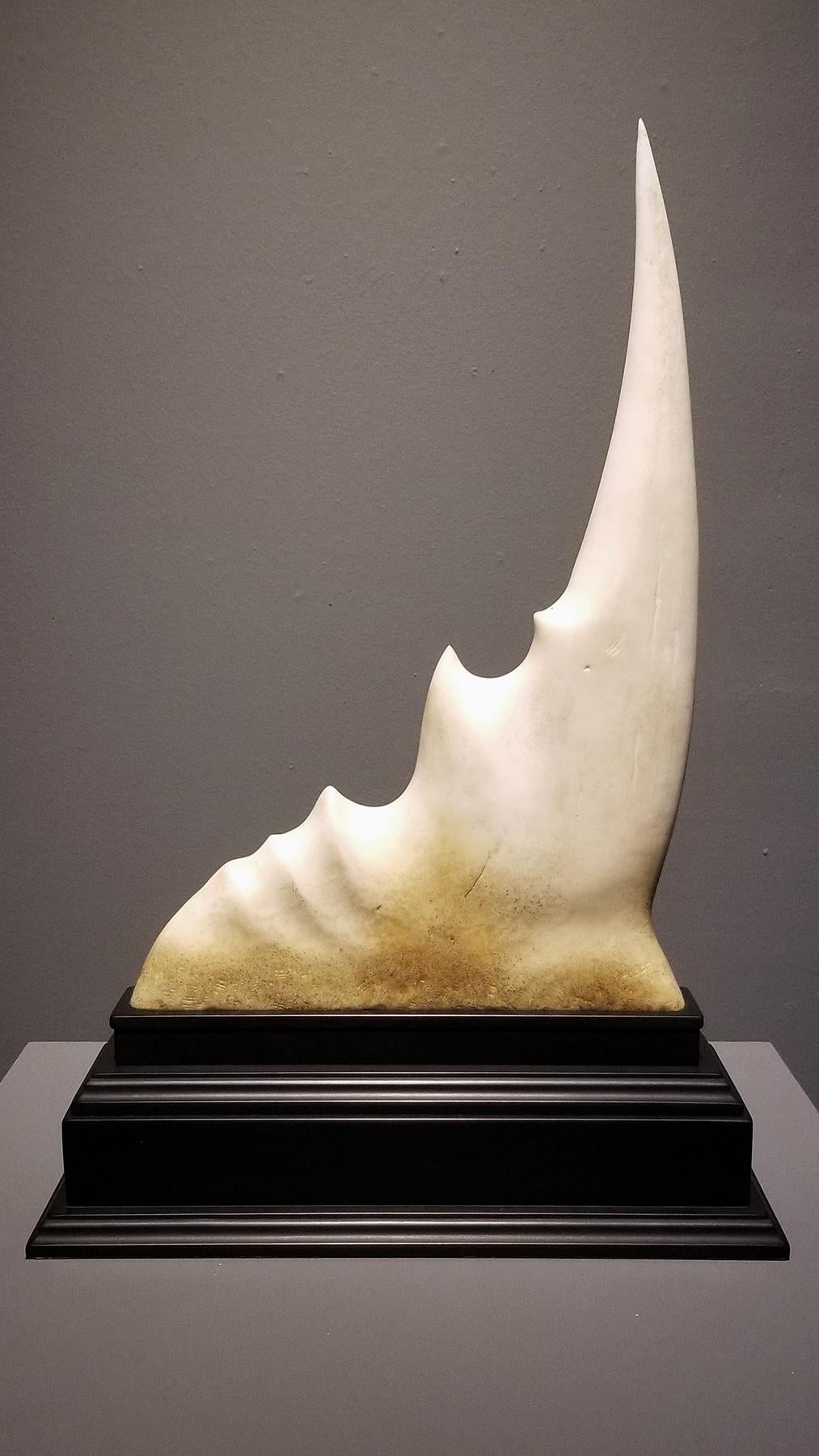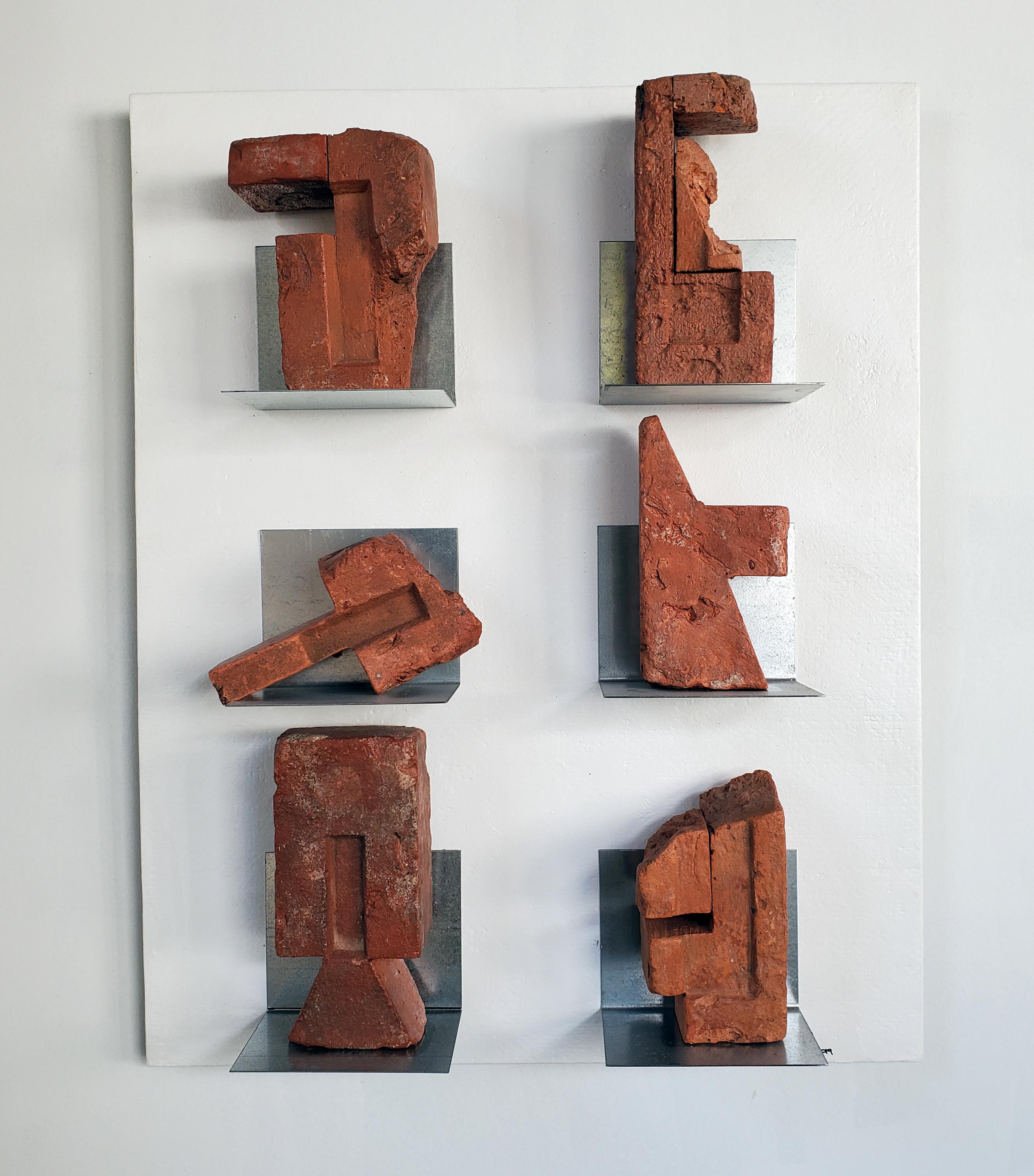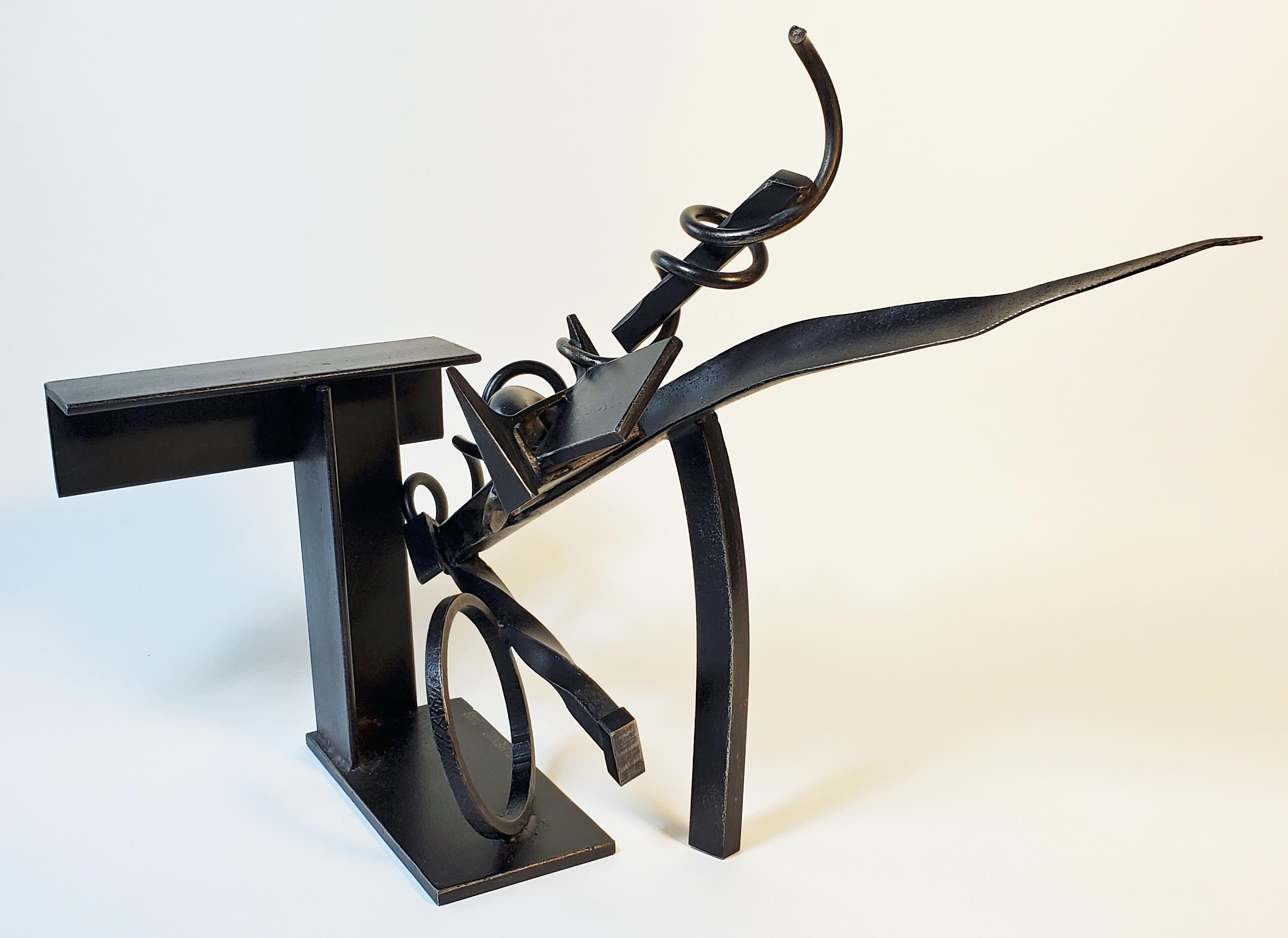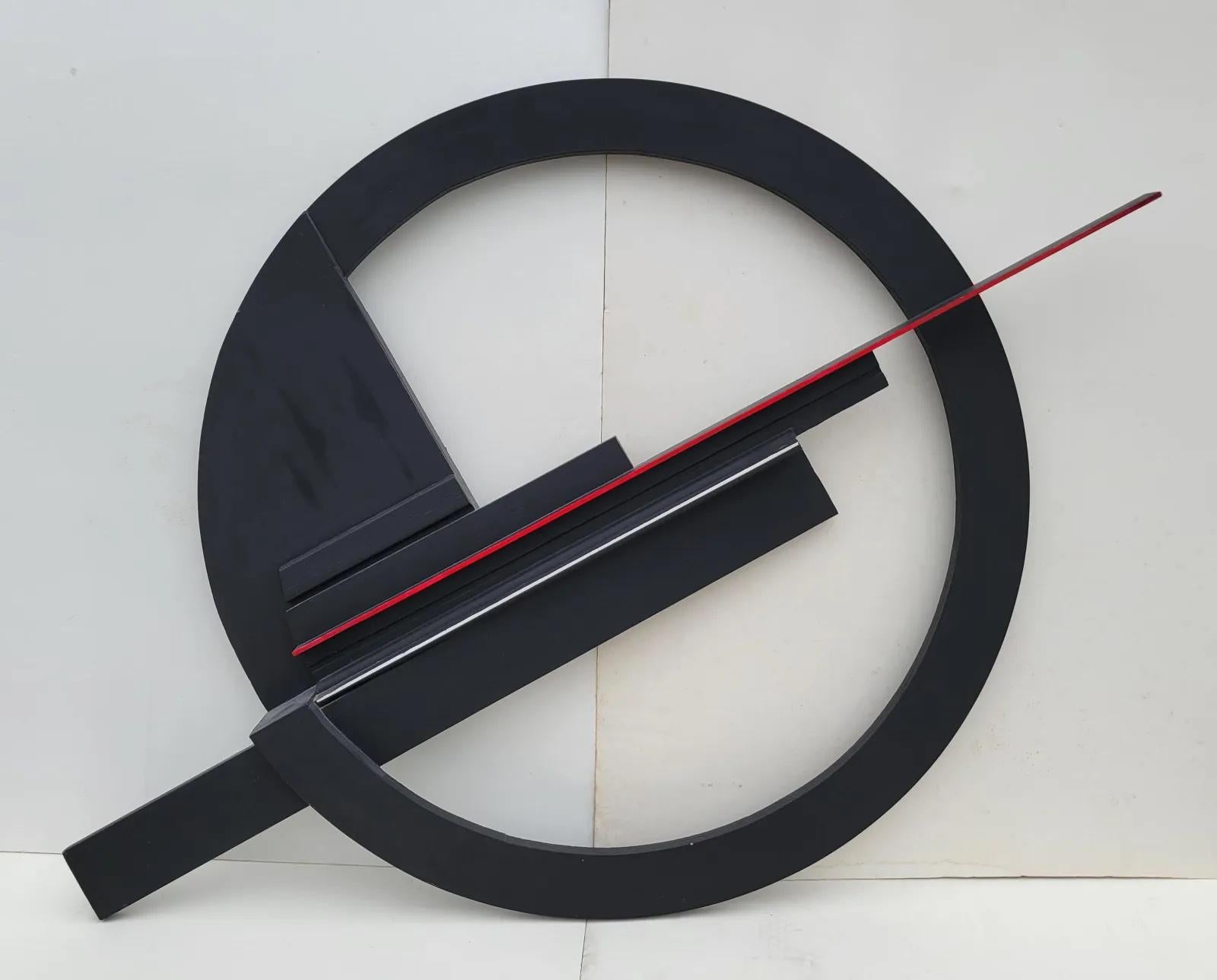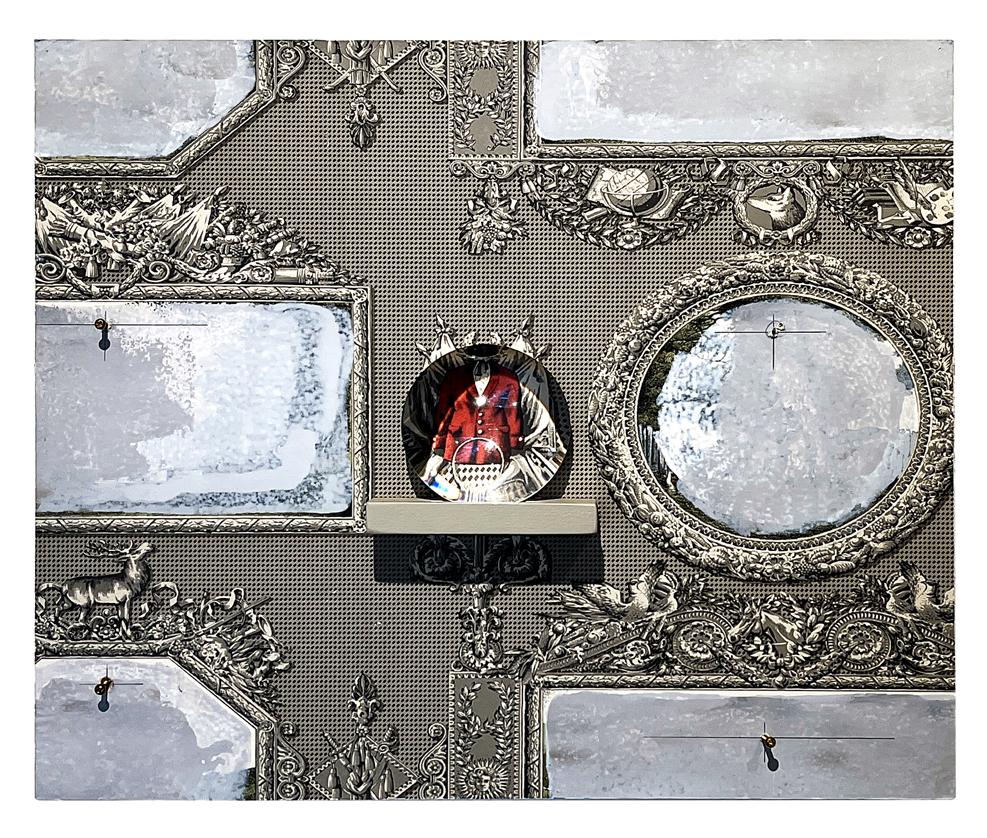Items Similar to John Albert Murphy Porcelain "Dark Days Ahead" Sculptural Nested Bowls
Want more images or videos?
Request additional images or videos from the seller
1 of 10
John Albert MurphyJohn Albert Murphy Porcelain "Dark Days Ahead" Sculptural Nested Bowls2016
2016
About the Item
"Dark Days Ahea" is in fact a glorious paper-thin porcelain sculpture with fluted sides. The "two bowls and one ball" are nestled and permanently fixed. The black and white linear design to the porcelain is relieved by the movement of the fluted sides of the "bowls." This complex design is both light and airy while being visually weighted by the innermost "ball" being covered in a silver glaze suggesting heavy stainless steel. The ceramic piece is slip cast porcelain, masking tape stenciled and glazed in the style of abstract expressionism, specifically Pointillism. It was fired in oxidation at 2230 degrees Fahrenheit. The sphere in the center has luster glaze.
John Albert Murphy heads as the Director the Ceramic Arts Department, the Birmingham Bloomfield Art Center. Murphy takes the reins at the BBAC after working more than 33 years as a program analyst at Ford Motor Co. While carving out a career in manufacturing, Murphy never stopped working in his preferred medium -- clay. His love affair with clay started in his first class with Gawaine Dart at Henry Ford Community College in 1968. Murphy has been teaching ceramic arts since 1986 as an Adjunct Instructor at Wayne County Community College; Henry Ford Community College; Schoolcraft College and Wayne State University.
He holds a Master of Fine Arts degree from Wayne State University, and a BFA from Eastern Michigan University in Ypsilanti. Some other well- known artists who attended Wayne State University are: Arthur Danto, Dr. Wayne Dyer, Tyree Guyton, Hughie Lee-Smith, Philip Levine, Casey Kasem and Helen Thomas.
He is accomplished in all aspects of ceramics, from hand building to wheel throwing and from Raku firing to cone-10 reduction firing in a downdraft kiln. His works can be found in collections as far away as Australia, China, South Korea, Switzerland, and Taiwan. He is currently Program Director of the Michigan Ceramics Art Association, past President of Michigan Potters' Association (1992-93), and member of the National Council on Education for the Ceramic Arts.
- Creator:John Albert Murphy (1950)
- Creation Year:2016
- Dimensions:Height: 4 in (10.16 cm)Diameter: 9.25 in (23.5 cm)
- Medium:
- Movement & Style:
- Period:
- Condition:
- Gallery Location:Detroit, MI
- Reference Number:1stDibs: LU128615465662
About the Seller
5.0
Gold Seller
These expertly vetted sellers are highly rated and consistently exceed customer expectations.
Established in 2014
1stDibs seller since 2019
95 sales on 1stDibs
Typical response time: 3 hours
- ShippingRetrieving quote...Ships From: Detroit, MI
- Return PolicyA return for this item may be initiated within 14 days of delivery.
More From This SellerView All
- John Glick Plum Street Pottery Glazed Bowl Reduction FiredLocated in Detroit, MI"Untitled" is a stoneware piece with the decorative layer of the rich toned glazes and markings that John was so well-known for. Each piece that John produced was unique. The lip on this piece is slightly scalloped and the shape is removed from the boring circular to mimic a gentle geometric design. He was seduced by the effects of the reduction kiln, which decreased the levels of oxygen during firing, inducing the flame to pull oxygen out of the clay and glazes changing the colors of the glazes depending on their iron and copper content. In this way he achieved the rich gradients of ochre and umber and variations in stippling and opacity. This piece is signed and stamped on the bottom. John was an American Abstract Expressionist ceramicist born in Detroit, MI. Though open to artistic experimentation, Glick was most influenced by the styles and aesthetics of Asian pottery—an inspiration that shows in his use of decorative patterns and glaze choices. He has said that he is attracted to simplicity, as well as complexity: my work continually reflects my re-examination that these two poles can coexist… or not, in a given series. Glick also took influences from master potters of Japan, notably Shoji Hamada and Kanjrio Kawai, blending their gestural embellishments of simple forms with attitudes of Abstract Expressionism. He was particularly drown to the work of Helen Frankenthaler whose soak-stain style resonated with Glick’s multi-layered glaze surfaces, which juxtaposed veils of atmospheric color with gestural marks and pattern. He spent countless hours developing and making his own tools in order to achieve previously unseen results in his work with clay and glaze. Glick’s “Plum Tree Pottery...Category
1970s American Modern Abstract Sculptures
MaterialsStoneware, Glaze
- "Ceramic Box with Lid" Stoneware Cream Glaze w/ Organic AttachmentsBy Gawaine DartLocated in Detroit, MIONE WEEK ONLY SALE The rich tones of the stoneware clay come through the soft creamy glaze that drips over the surface like melted vanilla ice cream over red devil cake. There are i...Category
1980s More Art
MaterialsCeramic, Stoneware, Glaze
- Magnificent John Glick Plum Street Pottery "Scalloped Box" Glazed StonewareLocated in Detroit, MIThis magnificent "Scalloped Box" is a stoneware piece with decorative layers of rich toned glazes and markings that John was so well-known for. He was, also, known for the undulating lip lines on his exquisite boxes that fit together like a puzzle. Each piece that John produced was unique. He was seduced by the effects of the reduction kiln, which decreased the levels of oxygen during firing, inducing the flame to pull oxygen out of the clay and glazes thereby changing the colors of the glazes depending on their iron and copper content. In this way he achieved the rich gradients of ochre and umber and variations in stippling and opacity. This piece is signed and stamped on the bottom. John was an American Abstract Expressionist ceramicist born in Detroit, MI. Though open to artistic experimentation, Glick was most influenced by the styles and aesthetics of Asian pottery—an inspiration that shows in his use of decorative patterns and glaze choices. He has said that he is attracted to simplicity, as well as complexity: my work continually reflects my re-examination that these two poles can coexist… or not, in a given series. Glick also took influences from master potters of Japan, notably Shoji Hamada and Kanjrio Kawai, blending their gestural embellishments of simple forms with attitudes of Abstract Expressionism. He was particularly drown to the work of Helen Frankenthaler whose soak-stain style resonated with Glick’s multi-layered glaze surfaces, which juxtaposed veils of atmospheric color with gestural marks and pattern. He spent countless hours developing and making his own tools in order to achieve previously unseen results in his work with clay and glaze. Glick’s “Plum Tree Pottery...Category
Late 20th Century American Modern Abstract Sculptures
MaterialsStoneware, Glaze
- Breathtaking John Glick "Scalloped Basket" Glazed Stoneware Reduction FiredLocated in Detroit, MI"Scalloped Basket" is a stoneware piece with the decorative layer of the rich toned glazes and markings that John was so well-known for. He was, also, known for the undulating lip lines on his exquisite pieces. The basket portion is shaped with gentle curves and a sculptural handle. Each piece that John produced was unique. He was seduced by the effects of the reduction kiln, which decreased the levels of oxygen during firing, inducing the flame to pull oxygen out of the clay and glazes changing the colors of the glazes depending on their iron and copper content. In this way he achieved the rich gradients of ochre and umber and variations in stippling and opacity. This particular "basket" also has the cool blues and grays that contrast with the umber. It is signed and stamped on the bottom. John was an American Abstract Expressionist ceramicist born in Detroit, MI. Though open to artistic experimentation, Glick was most influenced by the styles and aesthetics of Asian pottery—an inspiration that shows in his use of decorative patterns and glaze choices. He has said that he is attracted to simplicity, as well as complexity: my work continually reflects my re-examination that these two poles can coexist… or not, in a given series. Glick also took influences from master potters of Japan, notably Shoji Hamada and Kanjrio Kawai, blending their gestural embellishments of simple forms with attitudes of Abstract Expressionism. He was particularly drown to the work of Helen Frankenthaler whose soak-stain style resonated with Glick’s multi-layered glaze surfaces, which juxtaposed veils of atmospheric color with gestural marks and pattern. He spent countless hours developing and making his own tools in order to achieve previously unseen results in his work with clay and glaze. Glick’s “Plum Tree Pottery...Category
1970s American Modern Abstract Sculptures
MaterialsStoneware, Glaze
- Walter Midener "Contemplation" Seated Figure Clay Sculpture Mid-Century ModernLocated in Detroit, MISALE ONE WEEK ONLY “Contemplation” is an abstract clay sculpture of a female. The figure has both arms and legs extended, but the dignified pose suggests an intimate rather than a sexual moment. The sculpture is delicately rendered, but monumental in pose and clean composition reminiscent of the English artist Henry Moore. The surface is warm and slightly rough to the touch. This sculpture is in the round and beautifully balanced geometrically with the hands clasped behind the head forming a slightly flattened polygon shape that is echoed in the positioning of the legs and draped fabric of a presumed dress. The figure draws the viewer into her contemplation, peace and confidence. An exceptional piece by Midener. Walter Midener...Category
Mid-20th Century Modern Figurative Sculptures
MaterialsClay
- Julius Schmidt "Geometrics" Iron Casting Abstract Sculpture SignedBy Julius SchmidtLocated in Detroit, MISALE ONE WEEK ONLY Schmidt mainly worked in cast iron and bronze. This work reflects the influences of ancient cultures, natural forms, and the machinery of the modern age. Synthesi...Category
Late 20th Century Abstract Geometric Abstract Sculptures
MaterialsIron
You May Also Like
- Tusk of the Solipsisaur by Steve Brudniak, Surreal Assemblage StudyLocated in Austin, TXAn original sculpture by Austin, TX based artist Steve Brudniak. STEVE BRUDNIAK Tusk of the Solipsisaur (Study for Ontological Catastrophe), 2019 Carved and treated ABS and phenolic plastic 21 x 15 x 5 in Steve Brudniak is an American contemporary artist, actor and filmmaker, known for highly crafted, surreal assemblages invested with science elements and unusual characteristics. Brudniak pioneered use of many unconventional mediums including Tesla coil lightning, magnetic fluid, gyro mechanics, and biological preservations. Pieces generate ideas and themes of spirituality and psychological function. His work is in the collections of the Houston Museum of Fine Arts...Category
2010s Assemblage Abstract Sculptures
MaterialsPlastic, ABS
- Study for the Esoteric Dharma by Steve Brudniak, Surreal AssemblageLocated in Austin, TXAn original assemblage sculpture by Austin, TX based artist Steve Brudniak. STEVE BRUDNIAK Study for the Esoteric Dharma, 2014 Assemblage of glass, brass, marble and ritual oils of frankincense, galbanum, myrrh, coconut, jojoba and kalonji in nitrogen. 5 x 8.5 x 3.5 in Steve Brudniak is an American contemporary artist, actor and filmmaker, known for highly crafted, surreal assemblages invested with science elements and unusual characteristics. Brudniak pioneered use of many unconventional mediums including Tesla coil lightning, magnetic fluid, gyro mechanics, and biological preservations. Pieces generate ideas and themes of spirituality and psychological function. His work is in the collections of the Houston Museum of Fine Arts, the San Antonio Museum of Art, The El Paso Museum of Art and The Art Museum of South Texas, many private collections and hundreds of books and publications. His “Astrogeneris Mementos” became the first assemblage sculptures exhibited in outer space. The monograph, “The Science of Surrealism - Assemblage Sculpture of Steve Brudniak”, (2013) documents thirty years of the artist’s career, with a foreword by Guillermo Del Toro.Category
2010s Assemblage Abstract Sculptures
MaterialsMarble, Brass
- Compelling wall relief sculpture creates artistic puzzle, "Gallery of Misfits"By Mark Beltchenko StudioLocated in Grosse Pointe Park, MIThe "Gallery of Misfits" sculpture is a compelling wall relief that challenges conventional perceptions of construction materials, breathing new life into discarded elements. Compris...Category
2010s Assemblage Abstract Sculptures
MaterialsFound Objects, Board
- PremonitionBy Mark Beltchenko StudioLocated in Grosse Pointe Park, MIPremonition explores the theme of sudden and unexpected change in life, shifting from moments of serenity to moments of calamity. This theme resonates deeply with viewers as it refle...Category
Early 2000s Assemblage Abstract Sculptures
MaterialsSteel
- "Construction 1982" Abstract Wall Sculpture Contemporary Mid 20th Century ModernBy Seymour FogelLocated in New York, NY"Construction 1982" Abstract Wall Sculpture Contemporary Mid 20th Century Modern Painted wood assemblage, 36 x 45 x 4 inches overall. Note the label states 3 foot diameter referring to circular portion. Exhibited, Seymour Fogel Constructions Paintings and Drawing, 1984, typed on Graham Modern label verso Seymour Fogel was born in New York City on August 24, 1911. He studied at the Art Students League and at the National Academy of Design under George Bridgeman and Leon Kroll. When his formal studies were concluded in the early 1930s he served as an assistant to Diego Rivera who was then at work on his controversial Rockefeller Center mural. It was from Rivera that he learned the art of mural painting. Fogel was awarded several mural commissions during the 1930s by both the Works Progress Administration (WPA) and the Treasury Section of Fine Arts, among them his earliest murals at the Abraham Lincoln High School in Brooklyn, New York in 1936, a mural in the WPA Building at the 1939-1940 New York World's Fair, a highly controversial mural at the U.S. Post Office in Safford, Arizona (due to his focus on Apache culture) in 1941 and two murals in what was then the Social Security Building in Washington, D.C., also in 1941. Fogel's artistic circle at this time included Phillip Guston, Ben Shahn, Franz Kline, Rockwell Kent and Willem de Kooning. In 1946 Fogel accepted a teaching position at the University of Texas at Austin and became one of the founding artists of the Texas Modernist Movement. At this time he began to devote himself solely to abstract, non-representational art and executed what many consider to be the very first abstract mural in the State of Texas at the American National Bank in Austin in 1953. He pioneered the use of Ethyl Silicate as a mural medium. Other murals and public works of art done during this time (the late 1940s and 1950s) include the Baptist Student Center at the University of Texas (1949), the Petroleum Club in Houston (1951) and the First Christian Church, also in Houston (1956), whose innovative use of stained glass panels incorporated into the mural won Fogel a Silver Medal from the Architectural League of New York in 1958. Fogel relocated to the Connecticut-New York area in 1959. He continued the Abstract Expressionism he had begun exploring in Texas, and began experimenting with various texturing media for his paintings, the most enduring of which was sand. In 1966 he was awarded a mural at the U.S. Federal Building in Fort Worth, Texas. The work, entitled "The Challenge of Space", was a milestone in his artistic career and ushered in what has been termed the Transcendental/Atavistic period of his art, a style he pursued up to his death in 1984. Painted and raw wood sculpture...Category
1980s Assemblage Abstract Sculptures
MaterialsWood
- "Fox Hunt", wallpaper, acrylic paint, optical lens, screws, mounted on boardLocated in Toronto, Ontario“Fox Hunt“ is a wall relief panel by artist Heather Nicol, and measures 16x19x4“. Part of a body of work known as Brief Lives, this particular piece is comprised of wallpaper, wood, acrylic paint, screws and an optical lens...Category
21st Century and Contemporary Assemblage Still-life Sculptures
MaterialsGlass, Wood, Found Objects, Acrylic, Board
Recently Viewed
View AllMore Ways To Browse
Fine Silver Sculpture
Thin Sculpture
Fluted Carving
Black Porcelain Sculpture
White Chinese Sculpture
Fluted Porcelain
Luster Glaze
Chinese Head Sculpture
Black White Head Sculpture
Flute Sculpture
Silver Sculptures Medium
Porcelain Sculpture Head
Fluted Ball
Porcelain Mask
Light Nest
Thin Black Sculpture
Chinese Clay Sculpture
Porcelain Ball
